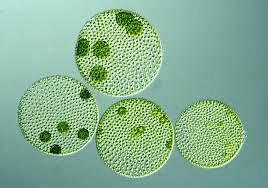All algae have
- chlorophyll a and b
- chlorophyll b and carotenoids
- chlorophyll a and carotenoids
- phycobilins and carotenoids
The Correct Option is C
Approach Solution - 1
All algae have chlorophyll a and carotenoids. However, the presence of other pigments like chlorophyll b and phycobilins varies among different groups of algae. Here is the correct combination for all algae:
Chlorophyll a and carotenoids
This combination ensures that all algae can capture light energy for photosynthesis and have protection mechanisms against photodamage.
So, the correct option is (C): Chlorophyll a and carotenoids
Approach Solution -2
Explanation:
- Algae are unicellular organisms which use photosynthesis to get their food.
- All algae have chlorophyll and carotenoids.
- Algae are classified based on their colour; these can be green, blue-green, red, and brown algae.
- Plants and algae which use photosynthesis have chlorophyll A.
- This means that chlorophyll A is a vital component for photosynthesis.
- Chlorophyll A is a green pigment which is found in the majority of plants and algae.
- Green algae contain chloroplasts with chlorophylls a and b but no phycobilins, whereas red algae frequently have chloroplasts with chlorophylls a and c as well as phycobilins.
- Most algae and seaweeds have high carotenoid content.
Top Questions on Algae
- Agar is obtained from:
- Phycoerythrin and Floridean starch is found in
- The plant body having holdfast, stipe and frond is a characteristic of
- The plant body having holdfast, stipe and frond is a characteristic of
- Identify the diagram of heteocyst.
Questions Asked in CBSE CLASS XII exam
- A parallel plate capacitor with plate area \( A \) and plate separation \( d \) has a capacitance \( C_0 \). A slab of dielectric constant \( K \) having area \( A \) and thickness \( \left(\frac{d}{4}\right) \) is inserted in the capacitor, parallel to the plates. Find the new value of its capacitance.
- CBSE CLASS XII - 2025
- capacitor with a dielectric
- You are Kirti / Keshav of 7, M.G. Road, Jhansi. You are disturbed by students littering parks during one-day picnics. Write a letter to the editor of a national daily suggesting ways to inculcate civic sense among students. Use the given cues to draft the letter.
- CBSE CLASS XII - 2025
- Writing Skills
- Your school is organising an inter-house ‘Maths Quiz’ Competition. As president of the Quiz Club, draft a notice informing students of Classes IX – XII about the competition. Include necessary details regarding the number of participants, registration date, etc. You are Akila / Akhil. Put your notice in a box.
- CBSE CLASS XII - 2025
- Writing Skills
Study the given molecular structure of double-stranded polynucleotide chain of DNA and answer the questions that follow.

(a) How many phosphodiester bonds are present in the given double-stranded polynucleotide chain?
(b) How many base pairs are there in each helical turn of double helix structure of DNA? Also write the distance between a base pair in a helix.
(c) In addition to H-bonds, what confers additional stability to the helical structure of DNA?- CBSE CLASS XII - 2025
- Molecular Basis of Inheritance
- Find the absolute maximum and absolute minimum of the function \( f(x) = 2x^3 - 15x^2 + 36x + 1 \) on \( [1, 5] \).
- CBSE CLASS XII - 2025
- Absolute maxima and Absolute minima
Concepts Used:
Algae
An Algae is a term mentioning a group of photosynthetic eukaryotic organisms. It has chlorophyll and nucleus but no root, stem, leaves and many features like normal land plants. Algae is both unicellular (e.g. Euglenophyta) and multicellular (e.g. seaweeds). Algae do photosynthesis and help in oxygen production
Algae can live in various habitats like moist rocks, soils, water bodies (both freshwater and marine) and in some animals (e.g. Sloth). Unicellular Algae belong to the Protista Kingdom and Multicellular algae belong to the Plantae Kingdom, but formerly all algae are categorized under kingdom Plantae for their photosynthetic nature.
Also Read: Difference Between Algae and Fungi
